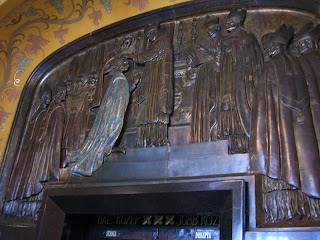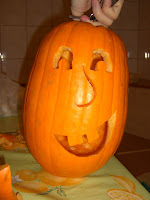Chapter 1: Ovens
Since the ovens here, all of them I've seen, I'm sure there's one or two professional model ovens in Hungary, all have a knob with arbitrary numbers to control the heat of the oven. This means nothing to me, and up to this last weekend I had not used an oven to bake anything, I've only used the broiler, because that's just about all these ovens are useful for until you can get a handle on the heat. So I put a paper clip on one of the racks and suspended my probe thermometer through that to take readings of the oven at different numbers. This gave me a ballpark idea of where the oven runs, but it was still wildly uncontrollable...

Chapter 2: Cookies
With the oven as tame and as reliable as a drugged circus bear it was time to bake, so we offered traditional chocolate chip cookies as a sacrifice to the oven gods. The dough was amazing! The baking was another story. It probably took 5 batches before we were happy with the results. We were constantly moving the orientation of the cookies on the sheet, adjusting the temperature, and doing rain dances in the living room, but to no avail some cookies were getting singed. Luckily we persevered as the flavor of the final product was not drastically affected, just the visual aesthetic. A side note: Saying "cookie" makes just about any Hungarian laugh because when they hear it they think "kuki" which is slang for penis.
Between batches of cookie dough I conceived an idea: put the broiler pan in the oven to block the direct heat of the broiler. This was a promising idea as it would shield the cookies from some of the direct heat and instead bake more by the indirect heat of the oven walls and the broiler pan. This was a major help! This enabled Franny to successfully bake her walnut crescent cookies which were not only absolutely beautiful, but delicious and perfectly baked. I learned earlier this week that Hungarians refer to this as dios kifli.
Chapter 3: Breakthrough!
Between batches of cookie dough I conceived an idea: put the broiler pan in the oven to block the direct heat of the broiler. This was a promising idea as it would shield the cookies from some of the direct heat and instead bake more by the indirect heat of the oven walls and the broiler pan. This was a major help! This enabled Franny to successfully bake her walnut crescent cookies which were not only absolutely beautiful, but delicious and perfectly baked. I learned earlier this week that Hungarians refer to this as dios kifli.
Chapter 4: Kissey Time

Chapter 5: It was the best of times, it was the worst of times...
Between batches of cookies I put my thermometer to further use. I've attempted caramel twice since I've been in Hungary; and without a thermometer. It was hard times without a proper gauge or recent enough experience to estimate the temperature of the caramel. The first batch prematurely recrystallized and became a chunky horrible mess after I added the cream and butter, not good. The second batch was nice and smooth, but when I tried to make caramel apples with it I succeeded only in making toffee apples: I had gone too far. So this time was just right. I had my trusty helper to tell me exactly when the caramel was ready to pull and cool. I sliced the solid sheet of caramel into ~2 inch squares and wrapped them in baking paper.

Chapter 6: End Game
Although the oven had been mastered for the walnut crescents that was not to last. Although we didn't experience the same problems as with the chocolate chip cookies the kiss cookies would be a little underdone at the proper time, or begin to scorch before the time was up. This was really frustrating after having believed that the oven had been tamed. Here's an important Hungarian lesson: just because something works for you once doesn't mean it'll work again... or something like that. :P

Chapter 5: It was the best of times, it was the worst of times...
Between batches of cookies I put my thermometer to further use. I've attempted caramel twice since I've been in Hungary; and without a thermometer. It was hard times without a proper gauge or recent enough experience to estimate the temperature of the caramel. The first batch prematurely recrystallized and became a chunky horrible mess after I added the cream and butter, not good. The second batch was nice and smooth, but when I tried to make caramel apples with it I succeeded only in making toffee apples: I had gone too far. So this time was just right. I had my trusty helper to tell me exactly when the caramel was ready to pull and cool. I sliced the solid sheet of caramel into ~2 inch squares and wrapped them in baking paper.

Chapter 6: End Game
These attractively festive tins were purchased at Tesco *shakes fist* for a decent price. Franny made them look even better by expertly installing the baked goods and candy to their new homes! Everyone I've given these to has loved them. I gave Trixi, my host teacher, the biggest tin because she has been the biggest help and because she's wonderful. She gave cookies to fellow teachers and I had the experience of walking into the teacher's room between classes and have teachers kind of point at me while nodding at Trixi and then Trixi would tell me that they loved the cookies. I had many requests for recipes and baking advice, what a day! Too bad two of the cookies are nearly impossible without the imported chocolates.
















































